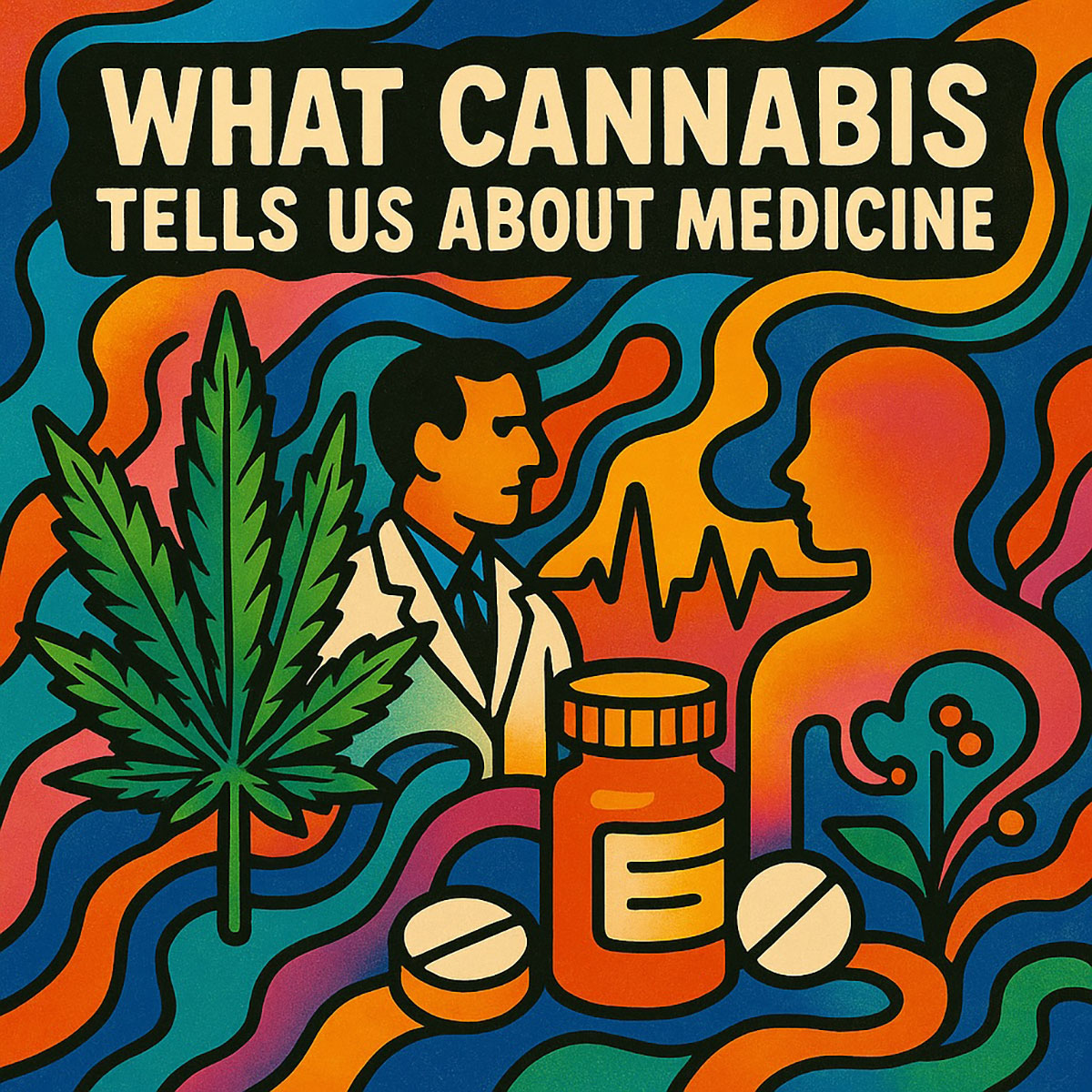Rules and Their Limits
Author: Dr. Kim, Medical Doctor at Aurea Care (Pen name)
Modern medicine likes rules.
One symptom. One cause. One molecule to fix it. A graph to prove it worked. That’s the playbook: tidy, testable, and tight. It gave us antibiotics, vaccines, insulin—slam dunks for a system built on precision and control. And yeah, it saved millions of lives. Full credit.
But cannabis never followed that playbook. Cannabis is not one compound but hundreds. Not one mechanism, but a chemical jazz choir. Its effects depend on dose, timing, your unique biology—even state of mind. Run it through a randomized trial and the data go all Jackson Pollock. Not because nothing’s happening. Because too much is—and not all of it lines up in well-behaved rows and columns.
To the medical establishment, cannabis looks like pharmacological noise. But that’s only because the establishment was tuned for clean signals. It was never built to hear jazz.
I have a confession. This isn’t really an article about cannabis. It’s about what cannabis exposes—about medicine, about how we define evidence, about the weird little boxes we try to stuff healing into.
And what it reveals isn’t just about medicine. (And when I say “medicine” here, I don’t mean the pill in the bottle. I mean the whole system—its rules, its playbook, its architecture.)
It’s about us.
And the cracks in the rules show up most clearly when patients bring conditions the system doesn’t know how to solve…
Where the Rules Break Down
When cannabis helps, it usually does it in the places where medicine throws up its hands. Not strep throat or pneumonia—those are clean victories for modern drugs. Think instead of the messy,
hard-to-pin-down conditions: fibromyalgia, PTSD, IBS, migraine, chronic pain, burnout. These don’t sit in
a single receptor or organ system. They ripple through the immune, nervous, endocrine, and digestive networks all at once.
Cannabis works there because it doesn’t go after one thing. It tweaks a bunch of knobs at the same time—THC and CBD taking the lead, the B-team molecules like CBG and CBN filling in the gaps, and terpenes layering on top. Less like swinging a hammer, more like fiddling with the thermostat until the house stops creaking.
And that’s precisely why it matters. Cannabis doesn’t just stretch the rules of modern, conventional medicine.
It breaks them.
The Machine Mindset
Modern medicine was born in the age of machines, and it shows. The model is one of control: isolate the mechanism, standardize the treatment, eliminate the variable. It’s a mindset that gave us anesthesia, sterile surgery, heart transplants—astonishing achievements. But it also narrowed what we’re willing to call medicine.
The body became a machine. Disease, a malfunction. Treatment, a wrench. Tighten the bolt, swap the part, problem solved.
But the body isn’t a machine. It’s more like a garden—living, adaptive, sensitive to context. And cannabis doesn’t act like a wrench. It works more like a gardener’s hand, coaxing balance rather than enforcing control.
You don’t fix a garden. You tend it.
That’s what makes cannabis challenging. Not that it’s unsafe. But that it asks medicine to rethink some of its deepest assumptions.
- What counts as medicine?
- Who gets to decide what healing looks like?
- And what if something falls outside the frame—but still helps?
How Medicine Became This Way
For most of human history, healing was woven into culture, ritual, and relationship. Remedies came from the earth. Knowledge was local and lived—passed down not in textbooks, but through touch, observation, and story. It wasn’t standardized. But it was deeply human.
That began to change in the 19th century, when chemistry met capitalism, and biology moved into the lab. Suddenly, a plant wasn’t medicine. A molecule inside the plant was. The goal shifted—from understanding the whole to isolating the part. Extract it. Purify it. Replicate it. Scale it.
And it worked.
This new model gave us aspirin, insulin, antibiotics, vaccines. It gave us anesthesia and sterile surgery and the power to stop a human heart—and start it again. These weren’t just medical advances. They were feats of wizard-level control. Of mastery.
But mastery came with a frame—one that defined what medicine could be. Only what fit inside that frame was allowed to count. Medicine became what you could isolate in a lab, dose in a vial, and run through a randomized trial.
Anything too complex, too personal, too hard to measure? If it couldn’t be bottled, charted, or
double-blinded didn’t count. Not because it didn’t work—but because it didn’t fit the model.
The success of modern medicine wasn’t just scientific. It was architectural. It delivered treatments—and rewired the whole operating system. Only certain kinds of knowledge were allowed. The rest quietly deleted.
It built a world of sterile rooms, isolated variables, and measured outcomes. A world that prized the
visible, the quantifiable, the repeatable. If it fits on a spreadsheet, it’s real. If it doesn’t—404: Not Found.
Cannabis doesn’t live in that world. It doesn’t play by those rules. And in refusing to do so, it reveals where the rules themselves fall short—scientifically and philosophically.
And that’s precisely why it matters.
Because the real question isn’t whether cannabis is medicine. It’s this: What counts as medicine in the first place? The neat little pill in the bottle? Or the messy plant that doesn’t like to be told what to do—but still helps?
That answer says less about cannabis than it does about us. It tells us whether we’re ready to admit that healing is often messier, more relational, and more human than the models we built to contain it.
Rethinking Medicine
In older traditions, a plant wasn’t a substance. It was a partner. Taking one meant listening, adjusting, learning—entering into a kind of dialogue with the living world. Healing was relational, not mechanical.
Modern medicine rewrote the rules. Healing became command-and-control: isolate the molecule, target the pathway, force the outcome. And for infections and broken bones, it worked brilliantly.
But the fastest-growing illnesses of our time aren’t so compliant. Autoimmunity, trauma, metabolic collapse, burnout—these don’t respond to command. They’re messy. They’re as cultural as they are biological. They reflect not just the failures of our cells, but the failures of the lives we’re living.
Cannabis comes at it from another angle. It doesn’t hammer a single symptom into silence. It tunes the whole system. Through the endocannabinoid network, it coaxes the body toward its own balance. And suddenly, pain, mood, appetite, and sleep start to shift. Not an order barked at the machinery, but an invitation extended to the garden.
Here’s the uncomfortable part. What cannabis reveals about medicine is simple, but unsettling. Modern medicine only trusts what it can measure, and in doing so it blinds itself to the things it can’t. Its tools define what it can see. And if something doesn’t fit the model, it gets tossed—sometimes along with the patients who needed it.
The problem was never the plant. The problem was the frame.
And maybe that’s why cannabis feels bigger than a therapy. It doesn’t just activate receptors; it activates questions: What counts as healing? Do we keep pretending the body’s a car you can fix with the right wrench? Or do we finally admit it acts more like a garden—or an ecosystem—alive, relational, and self-organizing?
What cannabis reveals about medicine as it stands is this: healing is less like fixing a broken part, and more like tending a garden.Because the body isn’t an equation. Or a car. It’s a living system. It’s jazz.
And the sooner medicine learns to hear it, the better.

